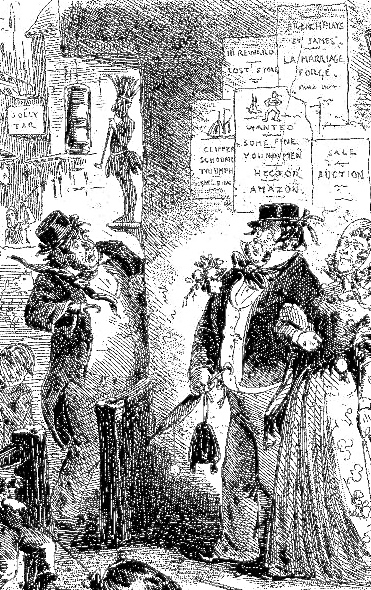Captain Cuttle
Sol Eytinge, Jr.
1867
Wood-engraving
10 x 7.4 cm (framed)
Dickens's Dombey and Son (Diamond Edition), facing III, 68.
[Click on image to enlarge it.]
Scanned image and text by Philip V. Allingham.
[Victorian Web Home —> Visual Arts —> Illustration—> Sol Eytinge, Jr. —> Dombey and Son —> Charles Dickens —> Next]
Captain Cuttle
Sol Eytinge, Jr.
1867
Wood-engraving
10 x 7.4 cm (framed)
Dickens's Dombey and Son (Diamond Edition), facing III, 68.
[Click on image to enlarge it.]
Scanned image and text by Philip V. Allingham.
[You may use these images without prior permission for any scholarly or educational purpose as long as you (1) credit the person who scanned the image, and (2) link your document to this URL in a web document or cite the Victorian Web in a print one.]
Captain Cuttle lived on the brink of a little canal near the India Docks, where there was a swivel bridge which opened now and then to let some wandering monster of a ship come roaming up the street like a stranded leviathan. The gradual change from land to water, on the approach to Captain Cuttle’s lodgings, was curious. It began with the erection of flagstaffs, as appurtenances to public-houses; then came slop-sellers’ shops, with Guernsey shirts, sou’wester hats, and canvas pantaloons, at once the tightest and the loosest of their order, hanging up outside. These were succeeded by anchor and chain-cable forges, where sledgehammers were dinging upon iron all day long. Then came rows of houses, with little vane-surmounted masts uprearing themselves from among the scarlet beans. Then, ditches. Then, pollard willows. Then, more ditches. Then, unaccountable patches of dirty water, hardly to be descried, for the ships that covered them. Then, the air was perfumed with chips; and all other trades were swallowed up in mast, oar, and block-making, and boatbuilding. Then, the ground grew marshy and unsettled. Then, there was nothing to be smelt but rum and sugar. Then, Captain Cuttle’s lodgings — at once a first floor and a top storey, in Brig Place—were close before you.
The Captain was one of those timber-looking men, suits of oak as well as hearts, whom it is almost impossible for the liveliest imagination to separate from any part of their dress, however insignificant. Accordingly, when Walter knocked at the door, and the Captain instantly poked his head out of one of his little front windows, and hailed him, with the hard glared hat already on it, and the shirt-collar like a sail, and the wide suit of blue, all standing as usual, Walter was as fully persuaded that he was always in that state, as if the Captain had been a bird and those had been his feathers. [Chapter IX, "In which the Wooden Midshipman gets into Trouble," 68]
Dickens's original illustrator, Hablot Knight Browne, in Profound Cogitation of Captain Cuttle (Part 5: February 1847) includes both the philosophical merchant seaman and his protegé, Walter Gay, whom Dickens gradually develops into the true protagonist of the nineteen-part novel. This crowded composition surrounds the pair with an enormous quantity of nautical bric a bric, including a model ship, memorabilia of a lifetime's voyages, a painting of a fully-rigged sailing ship, and a pair of crossed cutlasses above his dresser. In this 1867 scene from his portrait gallery of thirty figures in just sixteen illustrations, Eytinge is far more selective. Here, he focusses solely on the realistically-drawn, genial, one-handed sailor, but sets him, as it were, in a discretely nautical context, with the model of a sailing vessel on his mantelpiece in this scene from chapter nine.




Left: Phiz's initial portrait of one of Dickens's most loveable characters:
Dickens, Charles. Dombey and Son. Illustrated by Hablot Knight Browne (Phiz). 8 coloured plates. London and Edinburgh: Caxton and Ballantyne, Hanson, 1910.
_______. Dombey and Son.16 Illustrations by Sol Eytinge, Jr., and A. V. S. Anthony (engraver). The Diamond Edition. Boston: Ticknor & Fields, 1867. III.
Hammerton, J. A.. "Ch. XVI. Dombey and Son." The Dickens Picture-Book. London: Educational Book Co., [1910], 294-338.
Last modified 7 December 2020
